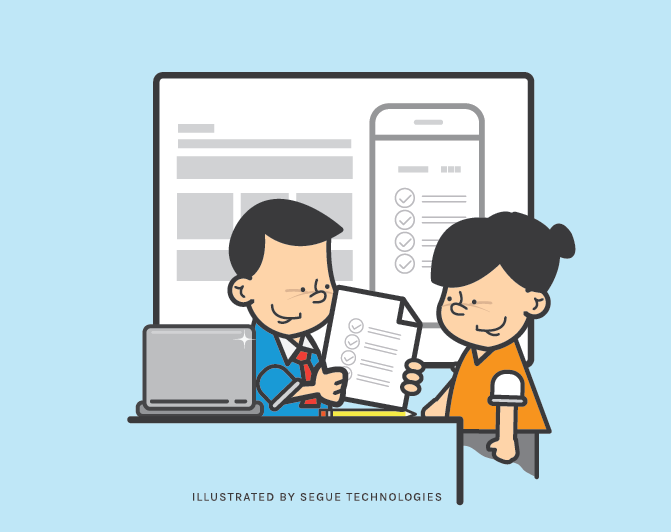Over our history of custom application development, and providing sustainment and enhancement to existing applications, Segue has developed a proven methodology for gaining a comprehensive understanding of a customer’s needs and the system(s) that support them. Whether we are tasked with bringing a new application to life, or taking control of an aging and troubled system developed before we were even born, we have applied our Discovery approach to quickly gain an expert understanding of the work at hand and establish a close partnership with the customer we are supporting. We understand web and mobile applications as tools that are meant to adapt to and support the customer’s needs. So starting with that understanding, we unravel the role of the application and identify effective approaches for development, problem remediation, and enhancements.

The following are two examples of our Discovery process in action, one for development of an enterprise web portal to serve tens of thousands of people, and the other for taking over a system that had critical flaws and wasn’t meeting its customer’s business needs.
Start Your Web or Mobile Application Right – Use Discovery to Scope and Plan Your Project
Segue’s customer, the Navy Mutual Aid Association (Navy Mutual) identified a need to improve their public website through an initial assessment of their current customer portal. With multiple stakeholders in the project, which would impact several existing sites, Navy Mutual worked with Segue to undergo an analysis of the current state of the Navy Mutual customer portal, a comparison with industry best practices, and a comprehensive needs assessment to establish requirements of a future state customer portal.
The Segue team followed our Discovery process and worked closely with the Navy Mutual points of contact and other vendors to develop a centralized business case, complete a readiness assessment, and provide recommendations for the re-development of the customer portal. The engagement took approximately two months and resulted in a large set of Navy Mutual defined deliverables, which included a Functional Requirements Matrix, a Roadmap for Development, and recommendations on Communication and Reporting. These deliverables would serve as the starting point for follow up work to re-develop a Navy Mutual Customer Portal that will serve the stakeholders’ and customers’ needs.
Get this Project back on Track – Discovery to identify and correct problems in an existing web or mobile application
The Association of General Contractors of America (AGC), founding member and managing partner of ConsensusDocs, approached Segue to address system defects and deficiencies within the platform, as well as to implement desired new features as part of a planned Phase II upgrade. AGC provided a list of known issues and planned enhancements, but due to the complexity of ConsensusDocs, Segue proposed conducting an initial assessment of the system, requirements, and defects –also known as Discovery.
Segue worked closely with personnel from AGC to examine the current system architecture, perform root-cause analysis for critical defects, and define high level requirements for new system functionality. Segue has also applied our knowledge of industry best practices to create additional recommendations for ConsensusDocs enhancements and improvements. The ultimate goal of this effort was to produce a scope of work and project cost/time estimate with a high confidence of successful delivery.
The primary deliverable from our Discovery effort for ConsensusDocs was an Identification, Analysis, and Recommendation (IAR) report designed to capture a deeper technical understanding of the system, assess the known problem areas, and any identify any overlooked problems or areas for enhancement. The IAR report was divided into the following main areas:
Current State Identification, which included information about the system in its current form, such as high-level system architecture descriptions, user identification, and platform information.
Current State Analysis, which provided technical details of the system and highlighted major findings. The information included the results of an in-depth code review of the current ConsensusDocs source code, analysis of existing user analytical data, stakeholder interviews, and observations.
Recommendations for Future State provided Segue’s recommendations for next steps based upon our analysis and understanding of best practices. These recommendations came in the form of suggested changes to the application infrastructure, recommended usability updates to the application user interface, and a suggested roadmap for implementation based upon our understanding of feature dependencies and costs.
In addition to these sections, additional supporting documents were produced. These included:
- High Level Functional Requirements
- Value Matrix – a tool designed to assist AGC with prioritization and decision-making
- High Level Implementation Plan
Using the technical and business information obtained and presented during the Discovery effort, Segue worked with AGC to determine their highest priority (and most cost impactful) corrections and enhancements. Upon initiation of support, Segue was able to use the information from the IAR report to keep AGC fully informed of the work being performed, and stay reliably within the agreed upon schedule and budget. Through our Discovery effort, we were able to give AGC clear expectations for the work required to bring ConsensusDocs into compliance with their needs and we were able to deliver as expected.
As these examples show, Segue has refined Discovery as a best practice in application development and sustainment. A comprehensive Discovery effort is a great way to start a new project on the right foot, or to determine how to wrangle in a problem plagued system already in use.
For more information on Discovery, download our eBook “Segue’s Discovery Process” by clicking the button below.